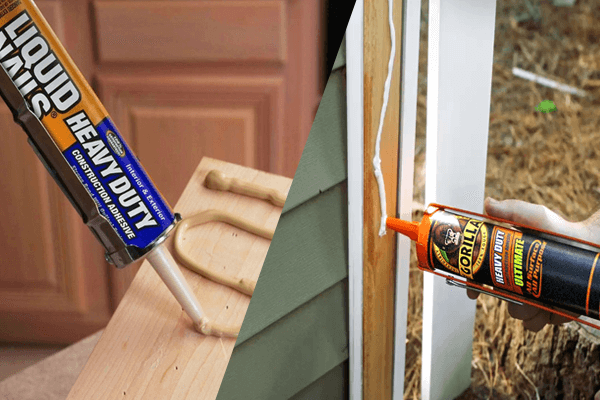When it comes to gluing two surfaces, choosing the right adhesive type can be tricky. Here in the US, Gorilla Glue and Liquid Nails are the two best options. But who wins the race between Gorilla Glue vs. Liquid Nail?
Turns out, both of their expertise is in different fields. If you want a strong wooden bond, Gorilla Glue will work perfectly for you. On the other hand, Liquid Nail churns out great results when working with varying materials. Liquid Nails provide a strong adhesive layer, which feels like rubber after application.
Today, we will see which brand is better for construction and other suited projects. We have included a comparison chart, so you don’t have to read the whole thing to get your answer.

Contents
Liquid Nails Vs. Gorilla Glue Comparison Chart
In a hurry? Check out the comparison chart to find out your best answer.
| Features | Liquid Nails | Gorilla Glue |
| Working surface | Works perfectly on Similar surfaces, but also work on varying ones | Good for varying material surfaces |
| Project type | Indoors | Outdoors |
| Curing time | About 15-20 mins | About 30 mins |
| Structure after curing | Rubber texture | Hardens after curing |
| Peel strength | Doesn’t resist pressure that much | Doesn’t peel off easy |
| Longevity | Will last 2 years on surfaces | Won’t break until you open the bond |
Liquid Nails: What makes them special?
Liquid Nails is an industry-leading product when it comes to joining materials. Having a high-strength internal adhesive bond, liquid nails can work their way through plastic, metal, wood, and so on. If you are a professional or a DIY guy, liquid nails’ multipurpose feature will do you wonders. Now, you can reach places where traditional nails and hammers can’t reach. Turns out, liquid nails work on almost anything, starting from house molding to all the way stones.
Project type
Working with similar materials just got easier with liquid nails. It provides a fast and permanent, and water-resistive bond, which lasts for years to come. You can work on any outdoor projects like brick veneer, concrete, ceramic, etc. If you are a professional construction worker, liquid nails will help you in projects where normal nails won’t do you any good.
Curing time and peeling
With a curing time of 15 mins, liquid nails can finish a project fast and easily. Unlike other glue types, liquid nails will give you better results in outdoor conditions where rain can come anytime. Its peeling strength, resistance to any sort of pulling after a perfect adjustment.
Longevity
Liquid nails have tough longevity of 2 years or more. It also depends on the temperature and humidity. If the temperature is similar to a desert, chances are the glue will last for more than just two years.
Pros
- Adjusts to a high-temperature environment
- Perfect adjustment for any surface
- Will last for years to come
- Works on both dry and wet surfaces
Cons
- The cleanup process is hard
- Removing it from the skin needs oil
Gorilla Glue: What makes it special?
Gorilla glue is another top-notch product for joining any material. However, it works great for any indoor project, especially wooden surfaces. If you have a broken wooden broomstick or a table, just add some gorilla glue and wallah. Gorilla glue is now possible to get the perfect joining of metals, stones, foam, etc. Turns out, you need just 30 mins to attach any indoor material at hand.
Curing time
The curing time of gorilla glue is about 30 minutes. Add some Gorilla Glue adhesives and tie the whole thing up. After the curing, the bond will stay tight even after applying pressure. Suppose your wooden table is broken, what will you do? Well, add home gorilla glue and start using the table like it never broke.
Project type
No matter what type of indoor projects you have, Gorilla glue will do them all. It can work on wood, stones, metals, ceramic, etc., with picture-perfect results. But for outdoor works, the rising temperature and moisture can degrade the glue joint. You should use gorilla glue in projects where the environment is constant.
Longevity of adhesive
With 2-years of minimal usage time, gorilla glue has one of the best adhesive longevity. However, too much moisture and heat can dampen the joint, causing it to break easily. If you are working on surfaces other than wood, chances are gorilla glue can’t withstand too much pressure.
Gorilla Glue vs. Liquid Nails: Head to Head
Though Gorilla glue and liquid glue are top in their game, only one is the true winner. Well, not technically. Both of them have their uses. When you want a solution for indoor work, gorilla glue is the way to go. On the other hand, Liquid glue works great in surface variations like wood to metal or metal to stone adjustment. Here are some differences between Liquid Nails and Gorilla Glue,
Curing time
The Liquid Nails need about 15 mins to cure, whereas gorilla glue takes 30-40 mins. A faster curing time will ensure faster work in both DIY and professional projects. However, the quick drying time comes at the cost of low resilience for dissimilar objects.
Toxic gas release
Being a solvent-based adhesive, liquid nails releases a toxic gas that can harm your body. Gorilla glue doesn’t have anything toxic and is harmless to use. Rule of the thumb, don’t touch liquid nails with your bare hands.
Removal from the skin
Both the liquid nail and gorilla glue will stick to your hands. But for how long? Well, to remove Liquid nail or Gorilla Glue, you need petroleum jelly or oil. However, Gorilla glue will come off easier than Liquid nails.
Strength and durability
Liquid nails are great for surface variations, whereas Gorilla glue works on the same surface materials. For example, Gorilla glue works better from wood to wood, rubber to rubber, and so on. The strength of gorilla glue decreases when the project involves more than surface type.
However, liquid glue withstands any surface type you have. Both of them are durable, where Gorilla glue is weaker compared to Liquid nails. You can expect Gorilla glue or Liquid Nails bond to last for 2 years at least.
FAQs
Is Gorilla Glue better than liquid nails?
Gorilla Glue and liquid nails have different uses. Gorilla glue works great for similar surface types, whereas liquid nails can go both ways. If you are working with wooden surfaces, liquid nails won’t do you any good. So, which adhesive is better depends on where you are using it.
Is Liquid Nails stronger than wood glue?
Liquid nails are stronger than wood glue, but only for wood-to-wood attachments. When the project includes surface variation, try using liquid nails instead. You will end up with a better adjustment for the project.
What is Liquid Nails good for?
Liquid Nails is good for metals, plastics, rubber, and so on. You can use it on wooden surfaces as well, but the bonds may break. Additionally, Liquid nails can handle any outdoor project, starting from ceramics to stone adjustment.
Can I use Gorilla Glue instead of Liquid Nails?
You can use gorilla glue instead of liquid nails, but the bond can’t withstand high temperatures. If you live in places where there is high heat, use liquid nails instead. This is the only reason liquid nails are the best option for outdoor projects.
What is the strongest no nails adhesive?
The strongest no nail adhesive is the Loctite PL Fast Grab Premium and the DELO MONOPOX VE403728. Both of them can resist high temperature and pressure for the strongest bond possible in no nails.
End Note
Getting to a complete conclusion isn’t easy, especially when you have the two best glue types. For us, Liquid nails have a better option, ending up on our shelves. However, woodworkers should prefer Gorilla glue as it has a better wood-to-wood bond.
Then again, liquid nails produce a toxic gas while drying. You need to be careful about that as well. This is all for today. Have a good day.
